Rare conjoined twins, born locked in embrace, successfully separated in Michigan

DETROIT – Sarabeth and Amelia Irwin were locked in an embrace when they were born at 11:06 a.m. June 11, 2019.
Conjoined from their chests to their bellies, the identical twins' arms wrapped around one another as they were carefully lifted from their mother's womb at Michigan Medicine's Von Voigtlander Women’s Hospital in Ann Arbor, said Dr. Marcie Treadwell, director of Michigan Medicine’s Fetal Diagnosis and Treatment Center.
About 14 months later, the twins returned to Ann Arbor, where they underwent an 11-hour surgery Aug. 5 at C.S. Mott Children's Hospital, becoming the first known set of conjoined twins to be successfully separated in Michigan.
"'They're so rare," said Treadwell, explaining that just 1 in 100,000 to 1 in 250,000 pregnancies involve conjoined twins. Few survive delivery, and even fewer live long enough to be discharged from the hospital and go home, like Sarabeth and Amelia did.
Video: Conjoined twins have life-saving separation surgery
Two teams of surgeons — one for each girl — and more than a dozen other medical staff spent months planning how they'd safely separate Sarabeth and Amelia, giving them a chance at independent lives.
Just a few weeks after the first-of-its-kind surgery, Sarabeth sucked on a pacifier, leaning against her father's leg on a blanket in the grass outside their house in Petersburg, about 10 miles north of the Ohio state line in Monroe County.
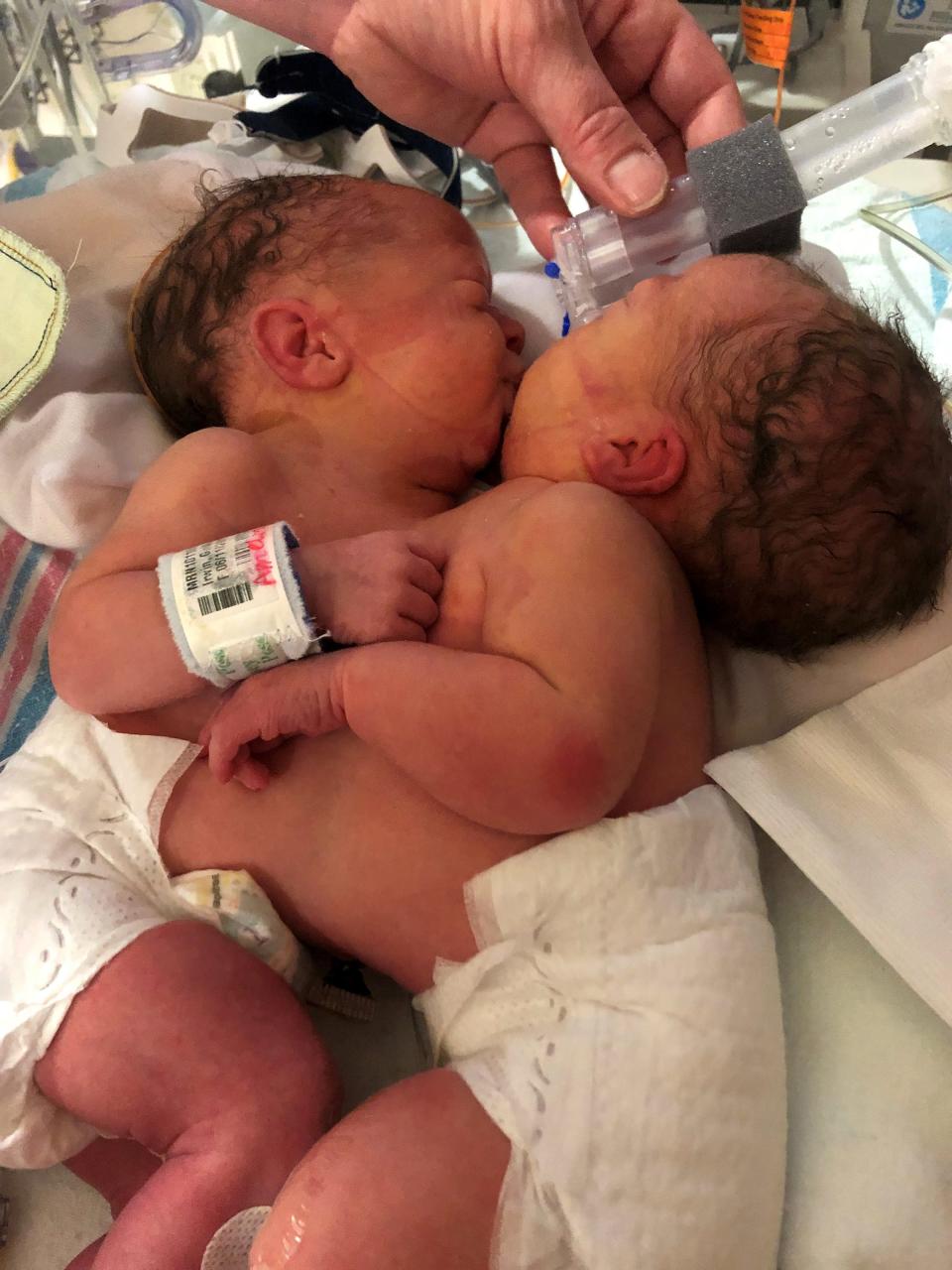
Amelia spotted a cell phone on the ground and began to crawl for it. She looked up at her big sister, Kennedy, who was running across the lawn, and said, "Sissy."
"Other than taking our word for it, you would almost never know that they were conjoined," said their father, Phil Irwin on a warm mid-September day.
Their mom, Alyson Irwin, smiled, and said, "They're doing great."
But neither Alyson nor Phil could ever have dreamed they'd be able to say that about their twins when they fist discovered they were conjoined in late February 2019.
Related: Conjoined twins have life-saving separation surgery
A concerning ultrasound
Something about the pregnancy was different, but Alyson, 33, who works in agricultural industry, selling feed and fertilizer to farmers, couldn't pinpoint what it was.
"I thought we were going to have a boy," she said. "It felt different" than her previous pregnancy, when she carried Kennedy, who's now a spunky 3-year-old who loves animals and playing on her backyard jungle gym.
More: USA TODAY NETWORK Launches 'Kidskind'
The Irwins looked forward to the 20-week prenatal appointment, set for Feb. 27, 2019. They were eager to see ultrasound images of their growing baby. They agreed they wouldn't find out the gender, and instead wanted to let it be a surprise at delivery.
Still, Alyson was pretty convinced her hunch was right.
"I thought we were just pregnant with a big old boy, so that's why I even bought a boy onesie and everything for a boy," Alyson said.
None of their previous prenatal doctor's visits gave them any inkling that they were having twins or that they might be conjoined.
The ultrasound technician moved the wand around on Alyson's belly, but then quickly excused herself to get the doctor.
"It may have been five minutes, but it seemed like forever," before the doctor came into the room, Phil said. "That's when we found out they were conjoined."
"It kind of felt like the worst news you could receive, you know?" Alyson said. "Especially because the statistics are not good.
"They had never seen anything like that before. So they said their hearts were breaking for us, ... but there wasn't anything they could do."
Their doctor referred them to a high-risk obstetrician, and within 24 hours the Irwins were in Ann Arbor, meeting with Treadwell at Michigan Medicine.
"I tend to always try to be hopeful, but I also have to be realistic," said Treadwell, who also is a professor of obstetrics and gynecology at the University of Michigan. "Giving people false hope is not particularly helpful for anyone."
Another ultrasound and a later MRI showed that the twins each had their own arms and legs. The girls were joined at the chest and abdomen, which can be a dangerous place for conjoined twins to fuse because the heart and other vital organs can be affected, Treadwell said.
"We had a long conversation that day, and then they knew that we have a multidisciplinary conference every week to discuss cases that are more challenging for things that have been found on ultrasound," she said.
"They left with a very good understanding that we weren't sure what was going to happen and there was some evaluation that was going to need to take place that would hopefully give us more information but that there was always going to be just a little bit of uncertainty most likely until delivery."
Still, absorbing the news was hard for the Irwins, who learned the odds were incredibly slim that their babies would survive delivery, let alone make it home or live long enough to see an eventual separation surgery.
But soon after, glimmers of hope began to shine through.
Dr. George Mychaliska, a pediatric and fetal surgeon at Mott, said he first met the Irwins in March of 2019.
"Even at that time, we had pretty good prenatal imaging, which indicated that they really had all separate organs, except a liver was fused in the midline," Mychaliska explained.
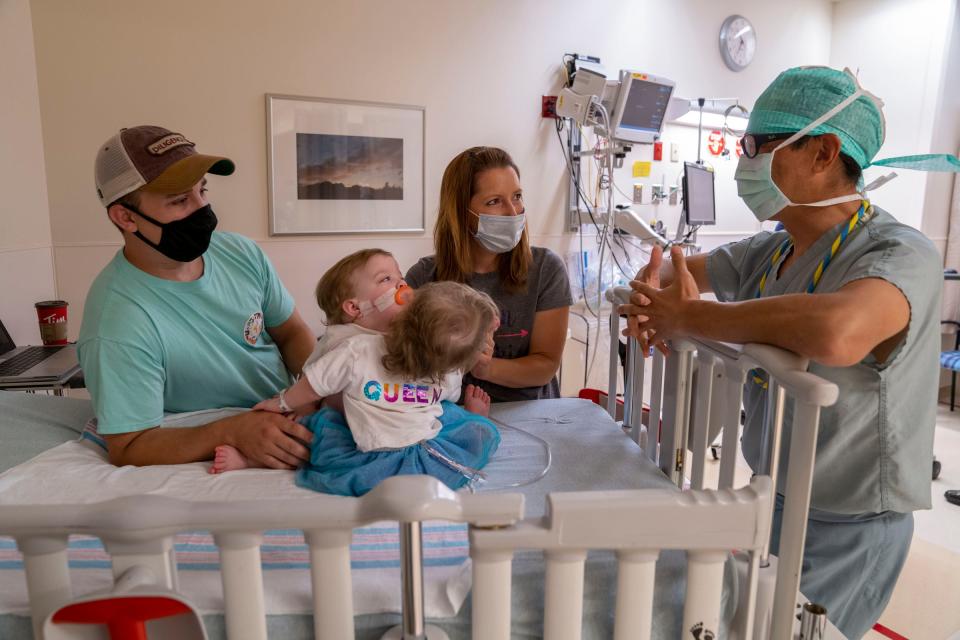
"I told them separation of the two babies seemed possible but much more evaluation and planning would be required. ... I remember it very well. I didn't want to be too optimistic because this was (going to be) a really long journey for us. We had never done it before. But I do remember being very hopeful with the family, that it's something that certainly was possible."
It was hope the couple desperately needed.
"We kind of went the whole time mentally prepared for the worst," Alyson said.
"We had one meeting where we had a neonatalogist who asked, 'Have you talked about pediatricians or car seats?' And we both looked at each other and started laughing because that was the first time we'd heard that" they should prepare to bring their baby girls home.
They tried to explain to their daughter Kennedy that her new baby sisters would be different from other babies. The team at Michigan Medicine stitched together two dolls, connecting them in the middle just like Amelia and Sarabeth would be, so she could understand how her special sisters would look when they arrived.
"They gave them to her so she could get used to seeing two dolls together," Alyson said. "She understood it before we had them, and then it was never a big deal to her at all."
'This is not an ordinary C-section'
Although the plan was to perform a cesarean section to deliver the twins between 35 and 36 weeks gestation, Treadwell said the babies were showing signs of distress at 34 weeks.
"Because we were following them closely, we were following the blood supply to the girls from the placenta," Treadwell said.
Amelia and Sarabeth shared an umbilical cord, which Treadwell said, had "a lot of different blood vessels in it, more than what you normally would see. We started noticing that some of the blood flow was no longer normal in the umbilical cord. And that's why we decided to move the delivery up a little bit from what we initially planned."
A 3-D model of the twins was made to simulate the delivery, and a team of doctors nurses and other medical staff was assembled.
"As you can imagine there's challenges with taking care of two babies that are attached. Where do you put IVs? And how do you help them breathe if they need help breathing? Those kinds of things," Treadwell said.
The models allowed Treadwell and her team to accurately estimate how big the incision in Alyson's abdomen would have to be to safely pull the twins from the womb.
Watch: Hero postal worker saves a boy from the side of a highway
March 31: Famed neurosurgeon Dr. James Goodrich, who separated conjoined twins, dies of coronavirus
"This is not an ordinary C-section because with an ordinary C-section, you just have to make an incision big enough to deliver one at a time," she said. "This surgery would require making an incision not only in her abdomen, but also in her uterus, that can accommodate the delivery of two kids simultaneously without pulling on those shared organs or causing any kind of disruption to them."
Mychaliska said the medical team planned for every possible outcome.
"We practiced what resuscitation would be like right after they were delivered," he said. "We had to figure out a process for monitoring two separate patients that were conjoined and have electronic medical records that had to capture two separate babies.
"We had to completely reconfigure a room in the neonatal ICU to not only have two sets of monitoring equipment, but to also have separate data capture so that we would know what's happening with Sarabeth and what's happening with Amelia. So at every stage of the journey, we had to modify what we normally do.
"That took a huge collaborative effort by so many people."
Defying the odds
June 11, 2019 dawned, and the Irwins made a 45-minute drive to Ann Arbor to finally meet their baby girls, knowing that as many as 60% of conjoined twins don't survive delivery, and even fewer live long enough to be discharged from the hospital.
Amelia and Sarabeth defied those odds.
“I remember them briefly putting the girls on my chest. It was very sweet and special being able to hold them and see them for the first time,” Alyson said. “It was just very surreal. There was so much adrenaline from everything that led up to that point.”
Alyson's sister stayed with her in the operating room while Phil followed the twins to the neonatal intensive care unit immediately after delivery.
The girls weighed a healthy 9 pounds, 4.5 ounces together — more than 4 1/2 pounds apiece.
"They were both vigorous when they came out," Treadwell said. "What I remember is the joy of seeing them, and the fact that they both looked good.
"I went down and saw them in the NICU and they were doing amazingly well. And I remember that much more than I remember the details of who was intubated or for how long."
Although the outlook was exceptionally good given the odds, being born prematurely and as conjoined twins, Sarabeth and Amelia remained hospitalized for 85 days.
Everyday life accommodations
How do you put conjoined twins in a car seat? This was among the challenges Phil and Alyson faced in the months following Amelia and Sarabeth's healthy delivery.
"We had to do a car bed," said Alyson.
Phil explained that it looked like a big box.
"It's got a couple handles that you can run on the seat belts through, a couple attachment points to reach up to the mounting points on the front seats," said Phil, 32, who works for NLB in Wixom as a controls technician and electrical apprentice.
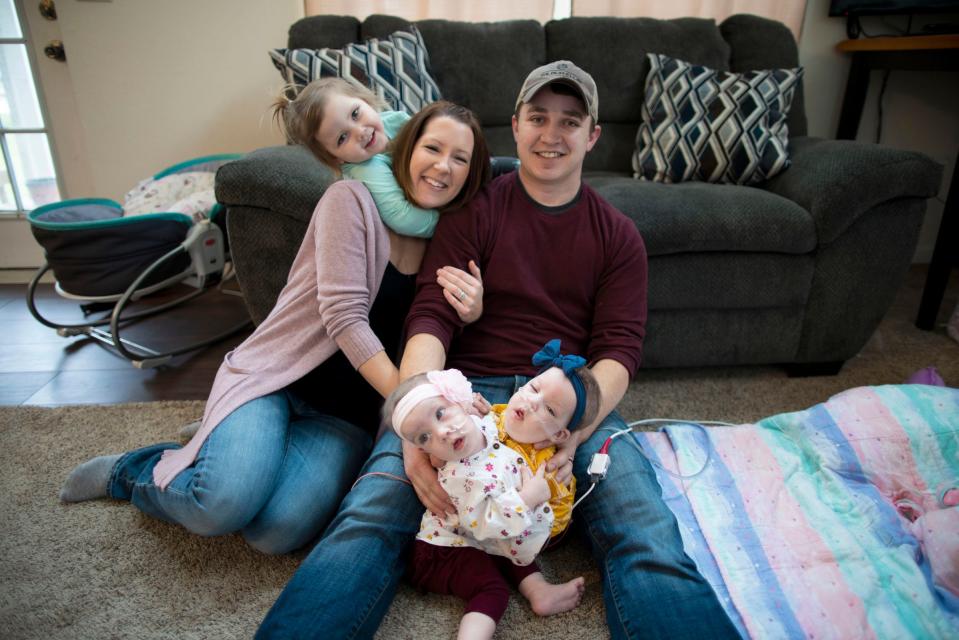
A manufacturing company created a custom swaddle sack for the girls that was built into the car bed.
"It had some zippers and a buckle attachment. And then there is a cummberbund that had super sticky Velcro that would reach across them. And that was great."
A Michigan Medicine team made a special swing for Amelia and Sarabeth that the Irwins brought home, so the girls could sit upright together.
When they outgrew it, Phil modified a four-hole rubber bucket swing.
"I looked at the girls and I looked at the swing and then I ended up just cutting the leg holes slightly bigger, and they loved that."
It's taken that kind of creative thinking to make it all work.
"When they were little, we were able to use just a regular baby carrier, too," Alyson said. "While were still in the NICU, one of the nurses was like, I think that would work. And so we tried it at the hospital and if you put them sideways, you could put both legs of each girl through one of the leg holes" in the carrier.
Both girls had nasogastric tubes that fed them, so Alyson and Phil had to quickly learn how to place the tubing back in the girls' noses if one or the other pulled out her sister's line.
"They just never quite picked up how to bottle feed right from the get go," Alyson said. "We've worked with it but this is the best way for them to get nutrition right now."
Sarabeth also needed supplemental oxygen.
"Our car is a rolling medic supply," Phil said. "We've got emergency respirators, extra oxygen and extra tape and tubes and everything you could need."
As the girls grew bigger and stronger, they began to talk more about how and when separation surgery might occur.
Planning for separation
Dr. Steven Kasten, pediatric plastic surgeon at Mott, began working with the Irwin family soon after the twins were born to plan how they'd create enough skin to be able to cover the abdomens of both girls once they were separated.
Amelia and Sarabeth were initially scheduled for surgery Feb. 13 to separate them. Months before that — in September 2019 — the girls underwent an initial surgery to add tissue expanders on both sides of their bodies.
"It is basically a silicone balloon, and we put one on each side of the twins, right along the area where they were joined," said Kasten said. "It gets put in with nothing in it. And then we let it heal up for a few weeks."
Phil and Alyson were taught how to inject saline into the expanders several times a week.
Watch: Son hugs parents tightly after ringing cancer bell
"It slowly blows up the balloon and creates extra skin," Kasten said.
But a week before they were scheduled for separation surgery, Sarabeth and Amelia got sick, and ended up back in the intensive care unit at Mott. The tissue expanders were deflated.
"It was bad," Alyson said. "They ended up being in the PICU (pediatric intensive care unit) for 40 days. And then COVID hit, and we canceled everything."
As the girls recovered in March from their illness — a cold that progressed to pneumonia — the global coronavirus pandemic made every decision more complex.
"There were a lot of a lot of conversations about it," Phil said. "We asked, do we stay in the hospital? Is it safer for the girls to stay in the hospital to guarantee that they do have an ICU bed? Because if they were to get sick again, how do we make sure that they can get back in?
"The general consensus among the team was, 'Get out of here. Go home. Isolate."
Amelia and Sarabeth were discharged March 17, just as the state entered a COVID-19 lockdown.
Back at home in Monroe County, the twins continued to grow and heal and Phil began to fill the tissue expanders again to prepare for separation surgery.
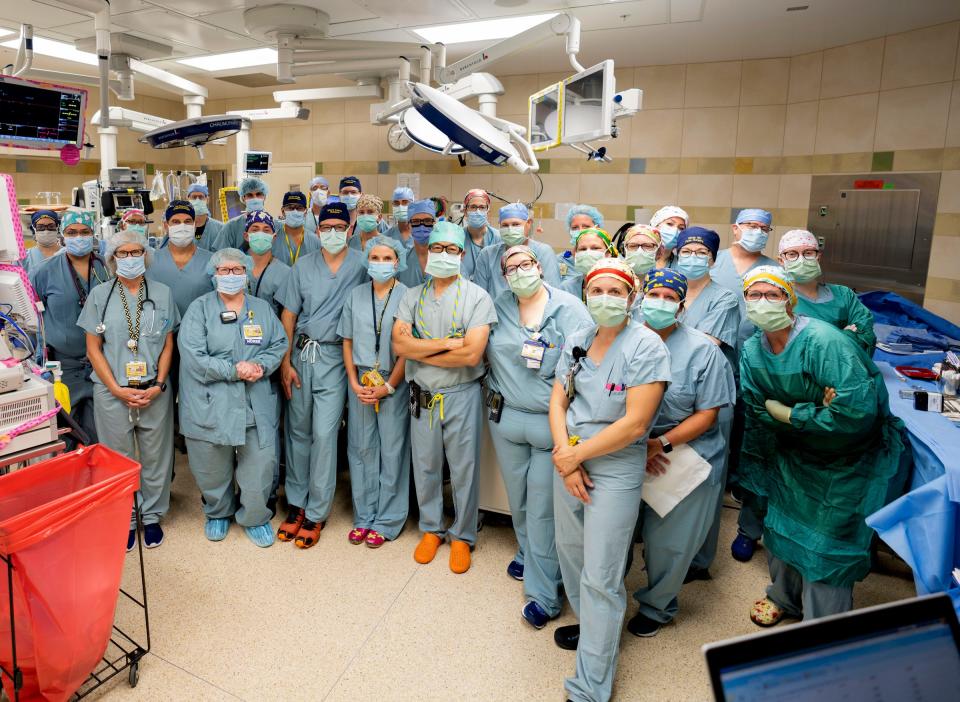
Just as they'd been used to prepare for Sarabeth and Amelia's delivery, the hospital's radiology team worked with bioengineers to create 3D models of the twins and their livers and other body structures to help the surgeons simulate what would happen in the operating room.
It was like orchestrating a complex medical ballet where every move, every step had to be choreographed and precise, Mychaliska explained.
Even the electrical capacity in the operating room had to be considered as two separate teams of experts would require duplicate medical equipment to work on each girl the moment they were separated.
Mychaliska led the surgical team on the morning of Aug. 5, along with Kasten and pediatric heart surgeon Dr. Richard Ohye for a procedure that they estimated could take as long as 16 hours, Phil said.
The couple waited outside the hospital in the car, getting constant updates about their girls, who entered the operating room at 7:30 a.m.
Some good news, at last
Sarabeth and Amelia shared a chest wall, but each twin had her own diaphragm muscles, said Mychaliska, who also is the co-director of the Fetal Diagnosis and Treatment Center and the Dr. Robert Bartlett collegiate professor of pediatric surgery at U-M.
They had one small, shared sternum bone that would have to be divided, and separate livers that were fused, he explained.
Although the twins had individual hearts, they shared an outer membrane or protective sack, called the pericardium.
Both girls needed an artificial sternum, which the cardiothoracic team built out of titanium bars to stabilize their chests, Kasten said. Gore-Tex fabric was used to place a patch over the holes in the pericardium around each of their hearts.
"One thing that we really didn't know until they were separated and the breathing tube came out was what their chest wall mechanics would be like," Mychaliska said. "Breathing is a complicated thing that involves your lungs, your diaphragm muscle and your chest wall, and it has to all kind of work in sync.
"We really didn't know how well their chest wall would work, but it worked actually beautifully."
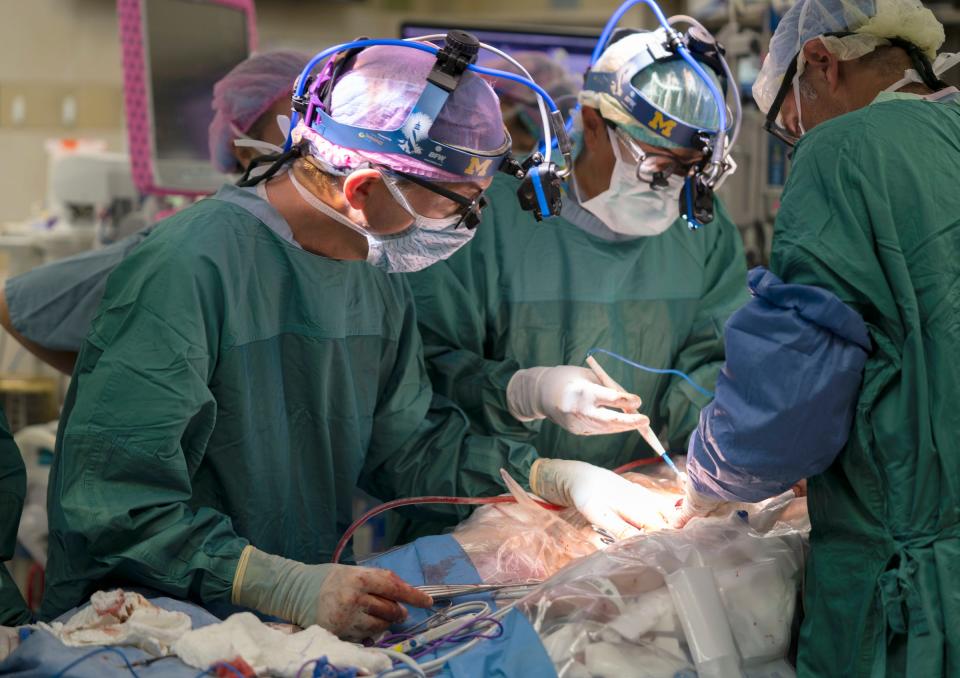
The team used an innovative intravenous fluorescent dye to guide them when they separated their livers, Mychaliska explained.
"There were not too many blood vessels that went from one baby to another," he said " ... An innovation that we observed on their CT scan is that when one baby received IV contrast in her vein, it outlined the edge of her own liver, and marked the middle. We thought to ourselves, it would be great if during the operation, we would know exactly where that line was, so we could divide it."
The process worked during surgery just as they'd hoped.
The first incision was made at 11:19 a.m., Mychaliska said. And by 1:11 p.m., they had been separated and placed at opposite ends of the same operating room table while surgeons began reconstructing their chests and abdomens.
Their teams were color-coded. Amelia's was pink. Her fingernails were painted to matched her surgical hat. Sarabeth's was yellow.
"I feel like my brain ran through every scenario forward and backwards," said Alyson as she contemplated what was happening in the operating room.
But Phil was very optimistic going into the procedure.
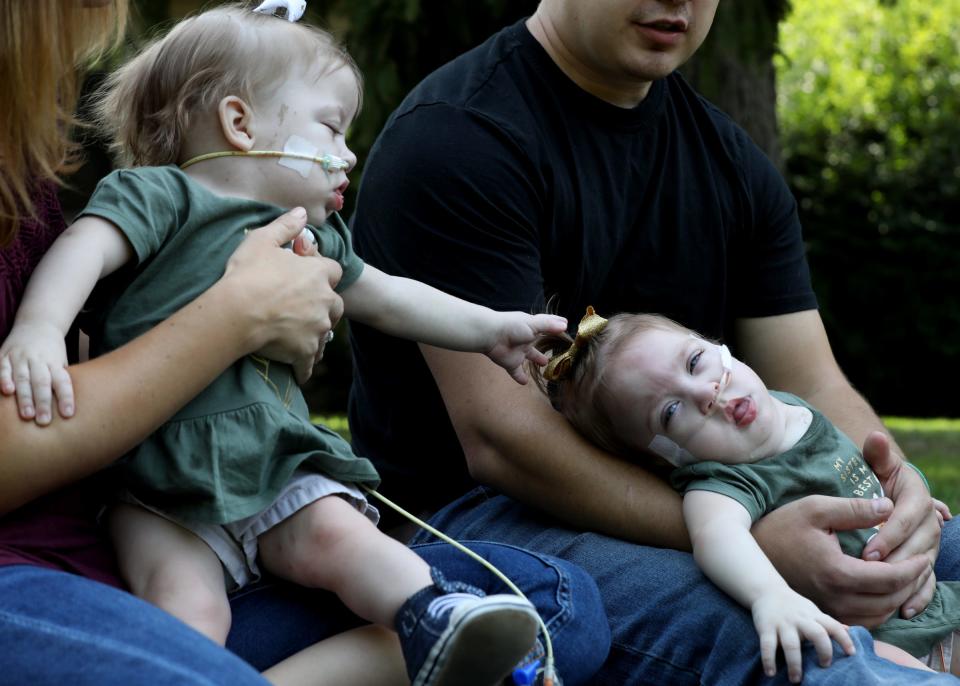
Sitting on the deck of their home by the fire pit, he told her, "I can't possibly begin understand what how terrible it could be ... but I can understand how great it's going to feel if things go well. So I'd rather focus on how great it's going to feel than be negative."
Because of COVID-19, the couple waited in the car outside the hospital during their surgery, getting frequent updates. They were thrilled when they got the news that it had gone so well, doctors even had time to construct a belly button for each of the girls.
Sarabeth came home from the hospital first, in late August. Amelia followed soon after, joining her family, their dog and two cats at home on Sept. 5.
Six weeks post surgery, Amelia and Sarabeth have matching scars that run down the center of their chests, forming a question-mark-like shape over their bellies that is likely to fade but might never completely disappear as they adjust to their newfound independence.
They may need additional surgeries as they grow and their bodies developed, but doctors are optimistic that Sarabeth and Amelia will grow up to be just like any other kids.
"Their outlook is really quite good," Mychaliska said, "especially with their parents. Their parents are really special people. They got the perfect parents for being conjoined twins. Not only because of their commitment, love and support, but because they're just very innovative and optimistic people. I think that really made a big difference."
Life for the Irwins is busier than ever now as they juggle occupational therapy and physical therapy appointments for the twins along with diaper changes and feedings, Sarabeth's oxygen tank and preschool for Kennedy.
But they wouldn't have it any other way.
"For us it's been a whirlwind, an absolute whirlwind," Phil said. "You look back at it, and it's like man, remember what used to stress us out? It's perspective."
As this pandemic continues, "people are realizing how much positive we really need.
"This has been a giant experiment in the power of positive and the power of prayer. You know, so positive news, people need that. People live on that."
Follow Kristen Jordan Shamus on Twitter @kristenshamus.
This article originally appeared on Detroit Free Press: Conjoined twins successfully separated in Michigan


